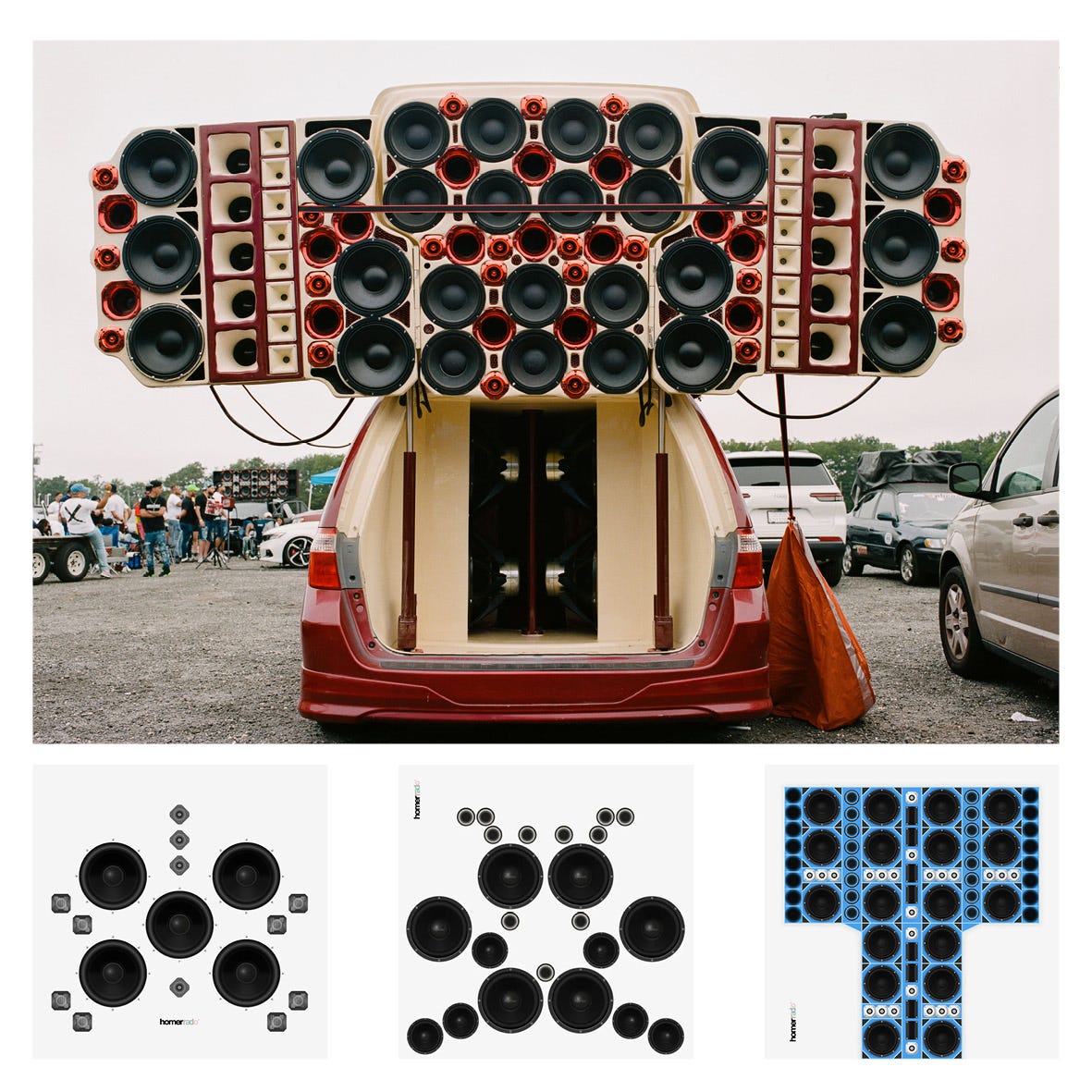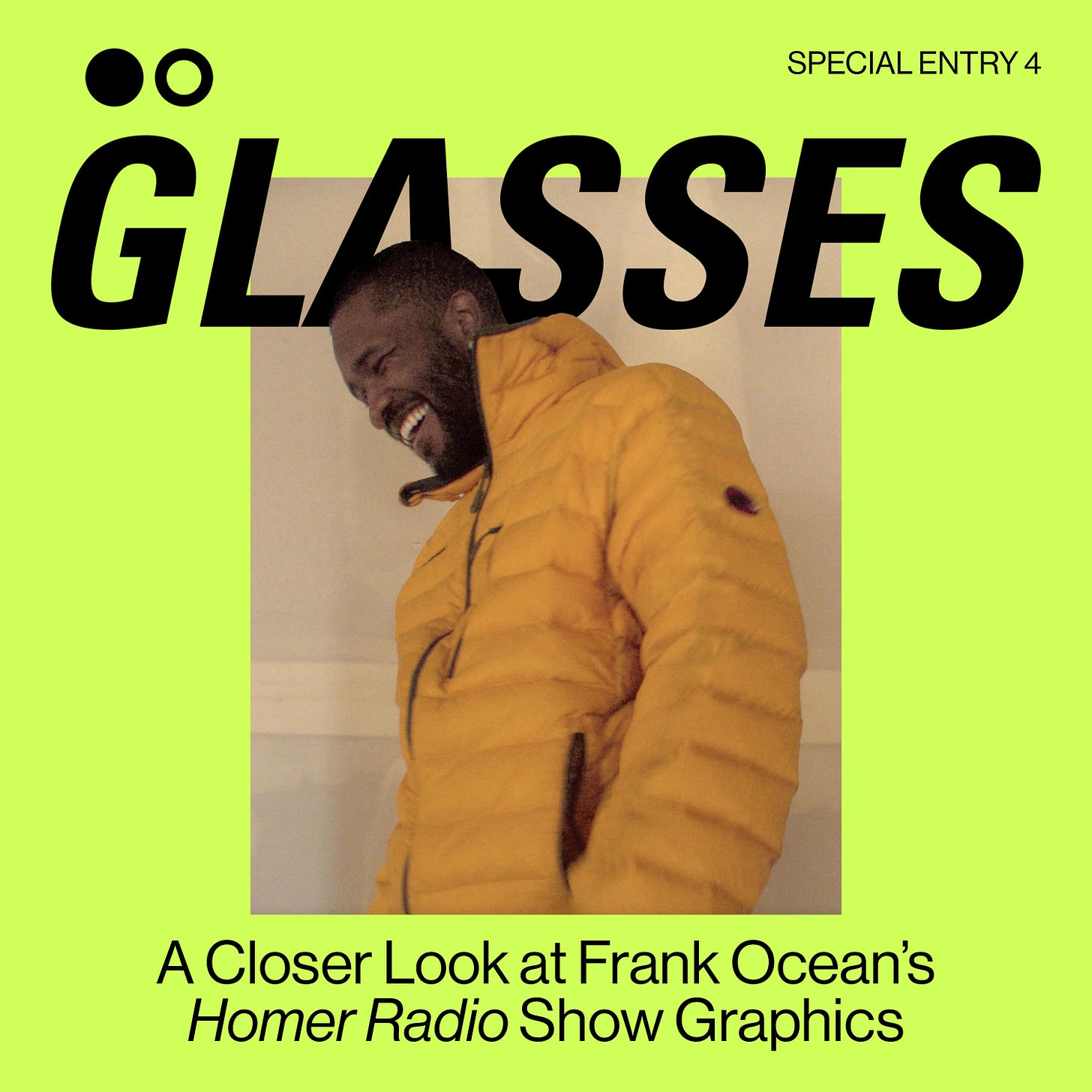A Closer Look at Frank Ocean's Homer Radio Show Graphics
SPECIAL ENTRY 4: dissecting the post-R&B king's enduring visual motifs
Twelve episodes of Homer Radio have now been released, and I think its time we talk about the graphic treatment of the show.
Homer Radio is Frank Ocean’s Apple Music radio show.
The broadcast is described as—
“A one hour window into what plays around our office after hours.”1
Frank has been dipping his toes into various creative outlets since his second studio album Blonde dropped in 2016. He’s dropped a handful of loosies/singles including, “In My Room,” “DHL,” “Lens,” among others. Most notably, he founded a luxury fashion/jewellery company called homer. From this company, spawned the radio show we’re seeing today.
To accompany each hour long broadcast, is its own unique cover graphic. I still can’t find who actually designed each one, but I have to imagine the creative director of homer, Michael Abel, has a consistent hand in it. Whether he’s the one making them or just keeping a keen eye on the collection, I don’t know.
Looking at all the covers together in order, you can immediately see there’s a clear design system in place. A consistent use of this #F3F3EC off-white background, and on top, an arrangement of analog speakers and speaker cones. Some more populated than others, the speakers are graphically translated onto this 2D plane, creating a beautiful visual and sonic representation of each episode. They all quietly feature the homer radio logo, designed by Tim Lindacher and Jannis Maroscheck.

The “radio” part uses a typeface called “Intra” by Sascha Bent & Max Winter. Maroscheck posted these gorgeous and insightful breakdown graphics online, illustrating just how meticulous and considered the creation of these logotypes were.

Poking around on Reddit, someone had asked the Frank Ocean subreddit about the possible inspiration behind these cover graphics. A few mentioned “Dominican car audio culture” being a reference, a big movement across NYC and the Dominican Republic where “musicologists” will completely deck out their cars with insane amounts of speakers.

The grid-like spread of the speakers in each Homer Radio cover definitely mimics the forms of these massive, illustrious car setups. Some covers are a little less reminiscent of the car’s systems, but nonetheless, the spirit is there.
Another influence people mentioned was contemporary New York artist, Tom Sachs. Sachs works primarily in sculpture, and has a series titled “Tom Sachs: Boombox Retrospective”. The exhibition features complex sculptures of boomboxes, twisted and reformed into various works of art.
“The exhibition at HYBE INSIGHT features thirteen sound systems that highlight the artist’s ability to distinctly transform ordinary, everyday materials into intricate works of art.”2
In the 1999-2015 retrospective show, Sachs’ boomboxes would play “60 minute playlists created by the artist, friends, and fans throughout the entirety of the show.”3 Frank may have even taken inspiration to do just a 60 minute show each time himself.
Frank Ocean & Tom Sachs’ Artistic Relationship
Ocean and Sachs are very much familiar with each other, having worked together in the past. Sachs having work featured in Frank’s 2016 visual album, Endless. Tom was given a “special thanks” after the release of Endless, and was also a contributor in Frank’s accompanying zine, Boys Don’t Cry.4
The artist and Ocean have "an ongoing creative dialogue" and there are "other projects [they're] dicking around with," Sachs said.5
One of the Sachs boombox pieces on display at the Brooklyn Museum plays Frank Ocean’s music on it, from a playlist Ocean curated himself.
Given this relationship, it’s clear that the Homer Radio cover art comes from Sachs’ influence on Ocean, mixed with the car audio culture mentioned earlier. The Brooklyn Museum even says the speaker piece Toyan’s carries this cultural influence.
“…and is inspired by Jamaican sound systems, according to the Brooklyn Museum.
How do you feel about the various Homer Radio covers? I think they perfectly fit into Frank’s visual design language him and his creative acquaintances have constructed over his career to this point, and acts as a fluid system to build upon with each episode.
https://news.artnet.com/art-world/tom-sachs-frank-ocean-magazine-617180








Love reading these!